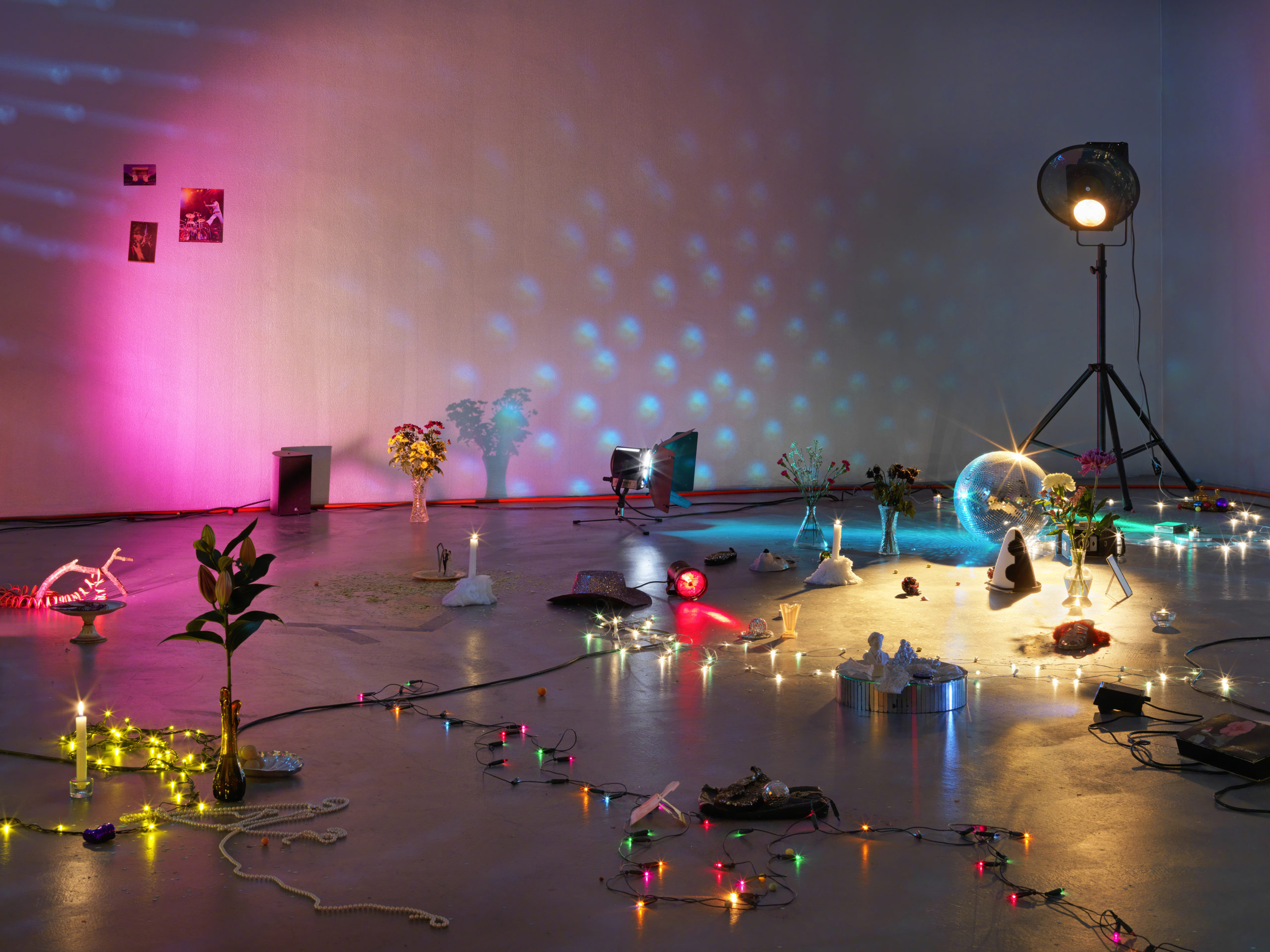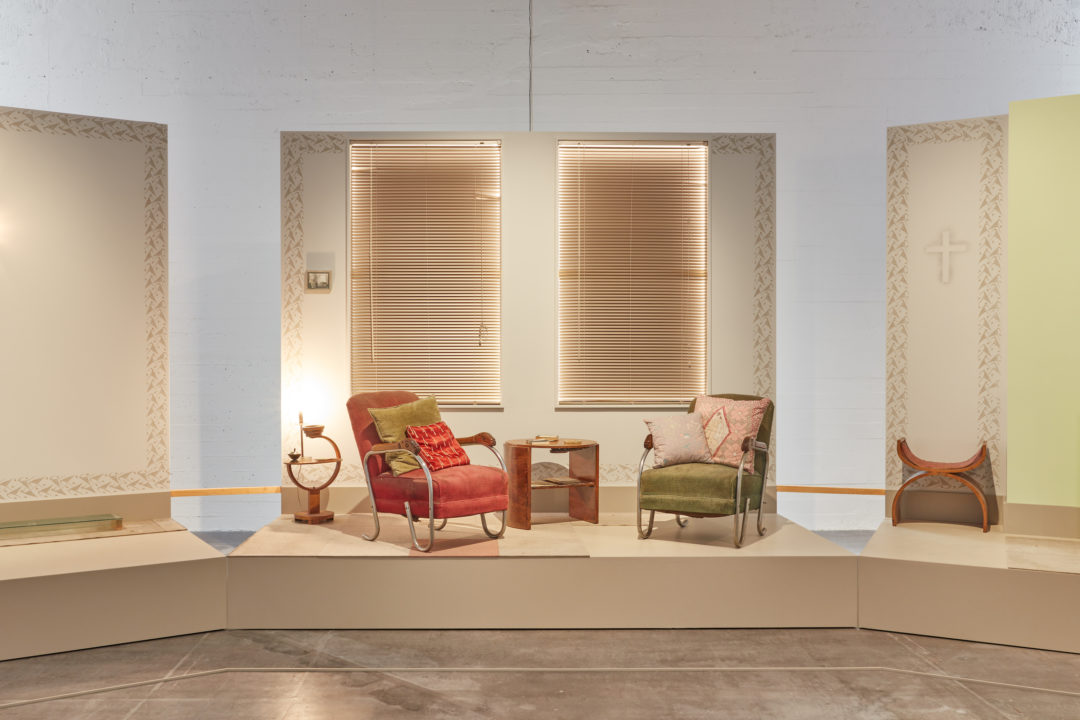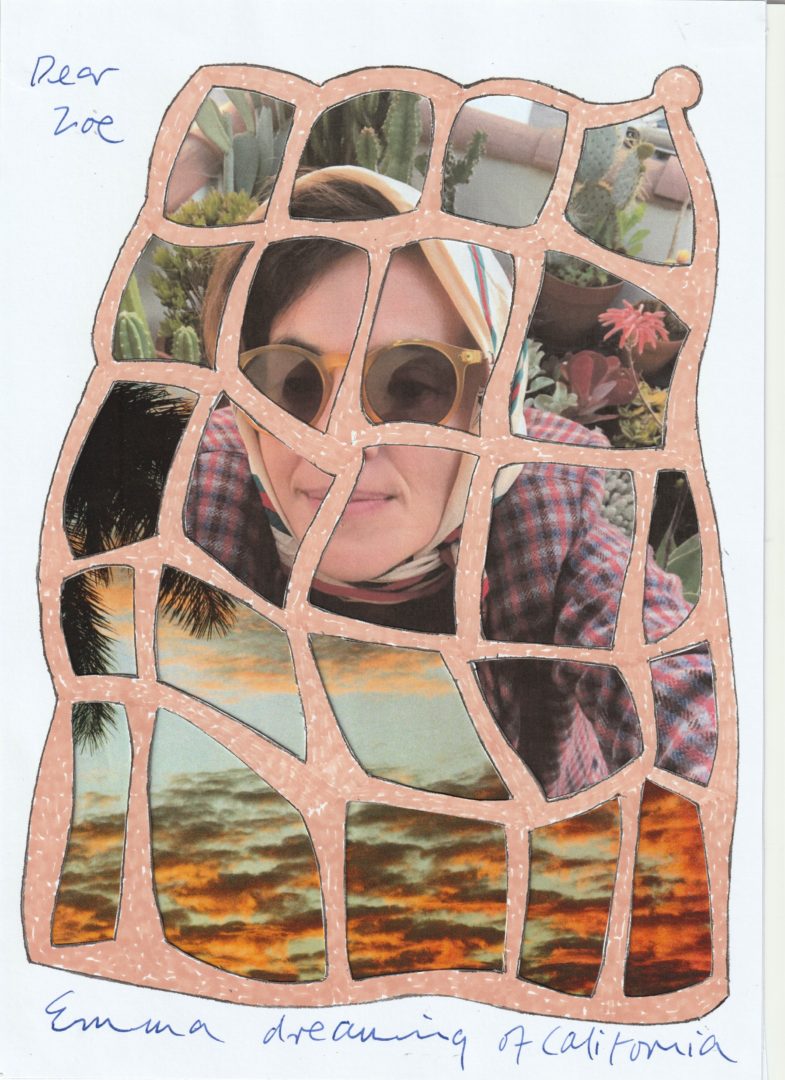Marc-Camille Chaimowicz at Wiels

Marc Camille Chaimowicz, Nuit américaine (American night)
Wiels, Bruxelles
17.02 – 13.08.2023
Adopting a cinematic term which refers to the artifice of filming a night scene during the day, artist Marc-Camille Chaimowicz and curator Zoë Gray—who is both co-author and protagonist of the project—present the chronicles of an exhibition at WIELS (Brussels). Each installment of the trilogy of works which constitute Nuit Américaine (Day for Night) consists of a presentation of the duo’s artistic and curatorial working methods. The project features Gustave Flaubert as a background character—an inventor of the modern novel and a favorite of the Franco-British artist—and takes on the topic of authorship and its underlying system of writing. The work has rarely been shown in Belgium1, and in this instance is filtered through a fictional lens with loosely structured rhythms which challenge binaries and the roles of the author and the viewer.

The adventure begins at the entrance to a dark corridor from which the sound of rock music from the 1970s is heard. Next, the scintillating lights of a disco ball from Celebration? Realife Revisited (1972-2000)—the first historic work; then, in a close-up and personal representation of the reconstitution of Chaimowicz’s living room, Nuit (Night) comes to a close with an ensemble of recent collages addressed to the curator, in the form of an epistolary exchange between the two which began in 2019. This last light-filled space explains the presence of Emma Bovary as well as the machinery behind the narrative device. The exhibition visited in reverse in order to exit brings back the night as if to close the circadian rhythm, showing us the other side of a subtle décor whose articulation lays out a non-retrospective synthesis of an uncategorisable and refined practice.
In the work of Chaimowicz, everything is a mere succession of transitory spaces set up between two modes, between two worlds2, between art and life. The viewer, filled with impressions of strangeness and familiarity, is sent reeling in their search for clues to scrutinise, to pore over, puzzling over the status of the objects presented. They are somewhere between stage decor and real life; with delicately arranged artificial interiors, traces of an afterparty left abandoned. In this ambiance, with its Warholian Factory vibe, Celebration is centred around a well-organised banality, an agglomeration of found objects, real flowers and confetti sprinkled directly onto the floor as if on the altar of a religion of art. Chaimowicz—who used to personally greet visitors in the first versions of the installation—consistently recreates a visually-pleasing hospitality. In his student days, the artist devoted himself to experimenting with forms which were far-removed from the minimalist aesthetic predominant at the time, combining installation and performance in unprecedented ways. The association of the two has yet to lose its aura, as Danai Anesiadou’s exhibition on the other levels of the WIELS can attest. D POSSESSION is equally centred around numerous objects, an emphatic scenography, where bodies are given equal importance to the objects in the installation, in a non-didactic cocoon where a festive spirit is liberating for body and soul.

Chaimowicz has incessantly attempted to “unlearn” and deconstruct the boundaries between work and pleasure, public and private, presence and absence. He manipulates domestic space—and in particular his own apartment—in order to highlight the ambiguity of the role and the production of the artist. Behind the seductiveness of his decors (which distinguish themselves with their rich motifs, soft pastels and minute arrangements), Chaimowicz also takes on a more critical role through the use of codes and concepts from the types of environments and techniques (textiles, artisanal forms) typically associated with the feminine. He presents these subterfuges under the cover of aesthetic tools, allowing space for glimpses of enjoyable detours. Specially created for the exhibition, The Hayes Court Sitting Room is an example of one of the artist’s nature-mortes-vivantes (still alive lifes) blurring the lines between domestic representation and performing the self.
The installation extracted from his London sitting room functions as a backdrop to a theatrical stage, with his own furniture set up among the wallpaper, personal knickknacks and nods to other artists (Eileen Grey, Rodin…). The ephemeral and subjective reconstitution of this reception area nonetheless manages to avoid the egotism of the presentation. By juxtaposing plinth-room dividers which bear the marks of the passage of time with photographs of a couple which have been hung reverse-side facing the viewer, all forming a part of the mise-en-scene in this interior space, he introduces another type of dialogue, offering multiple points of view as well as entry for the viewer of this ensemble.
The collage-letters near the end of the exhibition confirm an impression of the “dissimilar portrait3” weaved by the narrative. Through fashion magazine spreads, drawings and fragments of texts in the Dear Zoë installation emerge obsessions about refinement, erotic fantasies and other underlying leitmotivs present throughout the work. The pictorial compositions are a faithful projection of everyday thoughts on time spent in isolation during the pandemic, with all of their density and charm. The fragmentary solicitations sent to Emma B. become mixed together with those handed directly to the curator in face-to-face meetings. Most of the collages are adorned in frames, providing a temporal window onto a few chapters in a life. This part of the exhibition is configured as a kind of peaceful reading room, liberating the loose-leaf texts which are arranged around the pillars from the literary constraints of the narrative. In an installation reminiscent of Café du Rêve (1984) (Dream Café), meaning emerges from the absence of narrative progression. Here, several stages of the exhibition are revealed in negative. For example, in one of the collages the words “reserved”, “to sell” are found, which reference the preparations for the shipment of the Hayes Court sitting room to Brussels. The viewer is toted around like a camera, exposed to many plays on scale between the different objects and universes of Chaimovicz. With its nostalgic overtones, Nuit américaine offers a joyous zigzag through space and time, crossnig the labyrinth of a story/exhibition, in a departure from the usual linear chronology.
______________________________________________________________________________
1 Chaimowicz has nonetheless had a long-standing relationship with Belgium, through participation in a performance festival in Beursschouwburg en 1978 and a solo exhibition in Ostende (MuZEE) in 2008.
2 According to Hubert Besacier quoted in « Café du Rêve, un voyage épistolaire de Marc- Camille Chaimowicz », Lise Lerichomme, in : Correspondance d’artistes, du brouillon à la lettre ouverte, Marseille, Le Mot et le Reste, 2012.
3 As quoted from the artist in the visitor’s guide at WIELS.
Head image : Marc Camille Chaimowicz, Celebration? Realife Revisited, 1972 – 2000, Assemblage of various materials, Dimensions variable. Sammlung Migros Museum für Gegenwartskunst Photo:Stefan Altenburger Photography, Zurich © the artist
- From the issue: 104
- Share: ,
- By the same author: Lucy Raven, Hanne Lippard, Matthew Angelo Harrison, Florence Jung, Camille Picquot,
Related articles
Yoshitoro Nara at Guggenheim, Bilbao
by Guillaume Lasserre
Moffat Takadiwa
by Andréanne Béguin
Alias at M Museum, Leuven
by Vanessa Morisset

